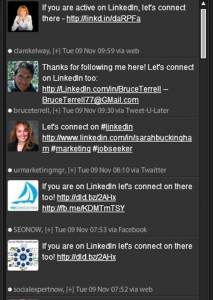I don’t know what happened in the last couple of weeks, but I’ve been bombarded by invitation to join people’s networks on Linkedin, from people whom I’ve never met before, had no interaction with, and worst of all – in their invitation message they gave me no compelling reason to be associated with them.
I have seen this on twitter as well, many times.
- What kind of people are you trying to attract to your network, by using this method to connect?
- How will you use your network, accepting any arbitrary person into it?
- How strong do you think your network will be, when you really need it? for example, when you’re looking for a job, and need a reference from a person in your network you haven’t met, and had nothing to do with?
Your LinkedIn connections should be a reflection of your business network, and not a game to accumulate “numbers”. There are two common points of view regarding connections:
- Some people are LIONs – Linked In Open Networker: These people will accept anyone to be their connection, as they see ANY new connection as a business opportunity.
- Some (me included) will pick their connections. I will connect with people I had some sort of business interaction or correspondence with. I also try to create offline relationships with people I meet online, if they are in my area, or when I go to where they are.
When you approach someone you don’t know or haven’t met yet on LinkedIn, it can be done in different ways:
- Sometimes LinkedIn will allow you to send a direct message, when you share a group, for example. When a person contacts you, and you go to see their profile, LinkedIn will allow you to send a message to them directly, as if they were already a contact. They can do one of two things – “Reply” or “Archive”. If they archive your message, nothing will happen.
- Ask to be introduced by a mutual contact. When you’re looking at a profile, you’ll see on the right hand side of the screen, how are you connected to them. If that person is open for invitations or introductions (see Settings), you’ll be able to ask for an introduction from one of your trusted connections. Again, stipulate clearly the reason for your contact, to make is easier for your contact, to connect you with theirs.
- Send an invitation to connect – give a compelling reason for the person to connect with you. Every person, before making any decision, will ask themselves, consciously or not, What’s In It For Me? (WIIFM). Answer that question for them. If there is no obvious benefit for the other person to connect with you, try another way to contact.
When you send this invitation to someone you don’t know, three things can happen:
– They can accept your invitation
– They can ignore your invitation
– They can indicate that they Don’t know this person
If the last option is chosen by 3 people you ask to connect to, LinkedIn will restrict the way you can invite people. You’d be sent to LinkedIn Jail, and only be released after reading and accepting LinkedIn T&C. - Premium Account feature – InMail. When you upgrade your account, you can send a limited amount (based on your subscription level) directly to other people in the network, whether they are in your network or not, whether you know them or connected to them, or not.
Use this feature when you need something from a person you had no interaction with before.
There are a few options available for you to use when communicating on LinkedIn. Adding to one’s network is not always the right approach. Always think from the recipient’s perspective. Use the right tool for the job. Like in any profession, using the right tool will get the job done easier and more effectively.












